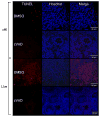Group B Streptococcus induces a caspase-dependent apoptosis in fetal rat lung interstitium
- PMID: 23624260
- PMCID: PMC3706500
- DOI: 10.1016/j.micpath.2013.04.008
Group B Streptococcus induces a caspase-dependent apoptosis in fetal rat lung interstitium
Abstract
Group B Streptococcus (GBS) is an important pathogen and is associated with sepsis and meningitis in neonates and infants. An ex vivo model that facilitates observations of GBS interactions with multiple host cell types over time was used to study its pathogenicity. GBS infections were associated with profound reductions in fetal lung; explant size, and airway branching. Elevated levels of apoptosis subsequent to GBS infections were observed by whole-mount confocal immunofluorescence using activated-caspase-3-antibodies and terminal deoxynucleotidyl transferase dUTP nick end-labeling (TUNEL) assays. The caspase inhibitor Z-VAD-FMK abolished the increase in TUNEL-positive cells associated with GBS infections, indicating that the GBS-induced apoptosis was caspase-dependent. Digital image analyses revealed that both GBS and the active form of caspase-3 were distributed primarily within the lung interstitium, suggesting that these tissues are important targets for GBS. Antibodies to the active form of caspase-3 colocalized with both macrophage- and erythroblast-markers, suggesting that these hematopoietic cells are vulnerable to GBS-mediated pathogenesis. These studies suggest that GBS infections profoundly alter lung morphology and caspase-dependent hematopoietic cell apoptosis within the lung interstitium play roles in GBS pathophysiology in this model.
Keywords: Ex vivo; Gram-positive; Quantitative colocalization; Respiratory; Sepsis; Streptococcus agalactiae.
Copyright © 2013 Elsevier Ltd. All rights reserved.
Figures





















Similar articles
-
Pretreatment with pancaspase inhibitor (Z-VAD-FMK) delays but does not prevent intraperitoneal heat-killed group B Streptococcus-induced preterm delivery in a pregnant mouse model.Infect Dis Obstet Gynecol. 2009;2009:749432. doi: 10.1155/2009/749432. Epub 2009 Dec 28. Infect Dis Obstet Gynecol. 2009. PMID: 20069051 Free PMC article.
-
Lactic acid is a potential virulence factor for group B Streptococcus.Microb Pathog. 2009 Jan;46(1):43-52. doi: 10.1016/j.micpath.2008.10.009. Epub 2008 Oct 26. Microb Pathog. 2009. PMID: 19010409
-
Reactive oxygen species involved in apoptosis induction of human respiratory epithelial (A549) cells by Streptococcus agalactiae.Microbiology (Reading). 2016 Jan;162(1):94-99. doi: 10.1099/mic.0.000202. Epub 2015 Oct 21. Microbiology (Reading). 2016. PMID: 26490153
-
Biofilm formation by Streptococcus agalactiae: influence of environmental conditions and implicated virulence factors.Front Cell Infect Microbiol. 2015 Feb 4;5:6. doi: 10.3389/fcimb.2015.00006. eCollection 2015. Front Cell Infect Microbiol. 2015. PMID: 25699242 Free PMC article. Review.
-
Perinatal Group B Streptococcal Infections: Virulence Factors, Immunity, and Prevention Strategies.Trends Microbiol. 2017 Nov;25(11):919-931. doi: 10.1016/j.tim.2017.05.013. Epub 2017 Jun 17. Trends Microbiol. 2017. PMID: 28633864 Free PMC article. Review.
Cited by
-
Heparan Sulfate Modulates Neutrophil and Endothelial Function in Antibacterial Innate Immunity.Infect Immun. 2015 Sep;83(9):3648-56. doi: 10.1128/IAI.00545-15. Epub 2015 Jul 6. Infect Immun. 2015. PMID: 26150541 Free PMC article.
-
Modulation of Death and Inflammatory Signaling in Decidual Stromal Cells following Exposure to Group B Streptococcus.Infect Immun. 2019 Nov 18;87(12):e00729-19. doi: 10.1128/IAI.00729-19. Print 2019 Dec. Infect Immun. 2019. PMID: 31548323 Free PMC article.
-
Intrinsic Maturational Neonatal Immune Deficiencies and Susceptibility to Group B Streptococcus Infection.Clin Microbiol Rev. 2017 Oct;30(4):973-989. doi: 10.1128/CMR.00019-17. Clin Microbiol Rev. 2017. PMID: 28814408 Free PMC article. Review.
-
Streptolysin S Promotes Programmed Cell Death and Enhances Inflammatory Signaling in Epithelial Keratinocytes during Group A Streptococcus Infection.Infect Immun. 2015 Oct;83(10):4118-33. doi: 10.1128/IAI.00611-15. Epub 2015 Aug 3. Infect Immun. 2015. PMID: 26238711 Free PMC article.
-
Cell death in acute lung injury: caspase-regulated apoptosis, pyroptosis, necroptosis, and PANoptosis.Front Pharmacol. 2025 Mar 21;16:1559659. doi: 10.3389/fphar.2025.1559659. eCollection 2025. Front Pharmacol. 2025. PMID: 40191423 Free PMC article. Review.
References
-
- Edwards MS, Nizet V. Group B Streptococcal Infections. In: Jack SR, Jerome OK, Christopher BW, Victor N, Yvonne AM, editors. Infectious Diseases of the Fetus and Newborn. 7. Philadelphia: W.B. Saunders: 2011. pp. 419–69.
-
- Desa DJ, Trevenen CL. Intrauterine infections with group B beta-haemolytic streptococci. Br J Obstet Gynaecol. 1984;91:237–9. - PubMed
-
- Verani JR, McGee L, Schrag SJ. Prevention of perinatal group B streptococcal disease--revised guidelines from CDC, 2010. MMWR Recomm Rep. 2010;59:1–36. - PubMed
-
- Heath PT. An update on vaccination against group B streptococcus. Expert review of vaccines. 2011;10:685–94. - PubMed
Publication types
MeSH terms
Substances
Grants and funding
LinkOut - more resources
Full Text Sources
Other Literature Sources
Medical
Molecular Biology Databases
Research Materials

